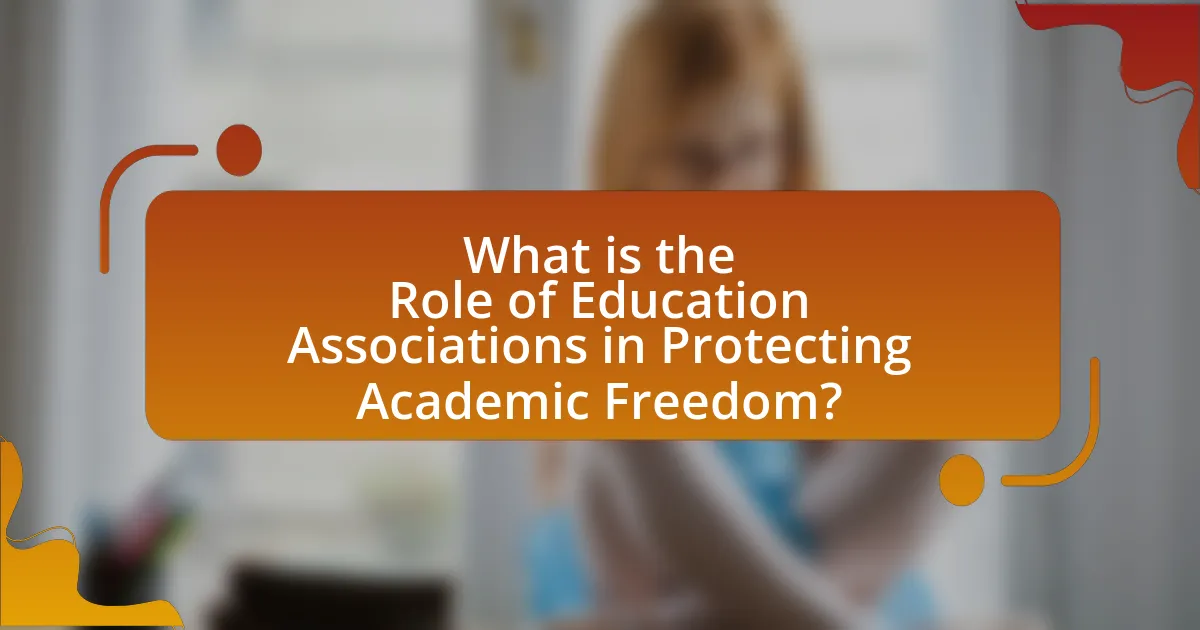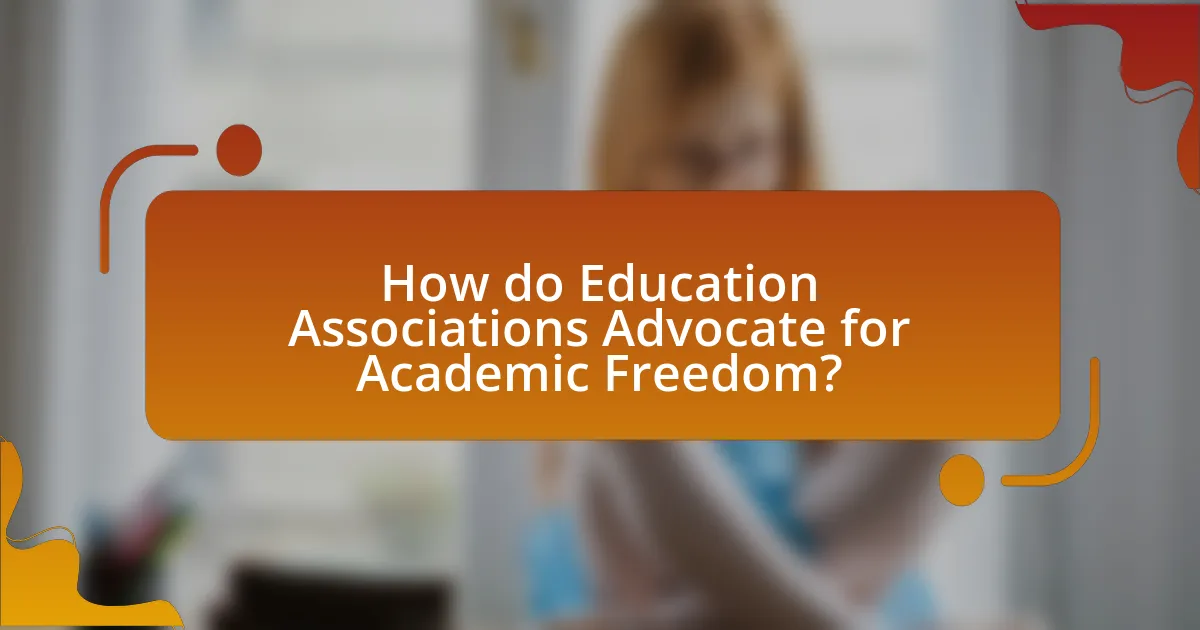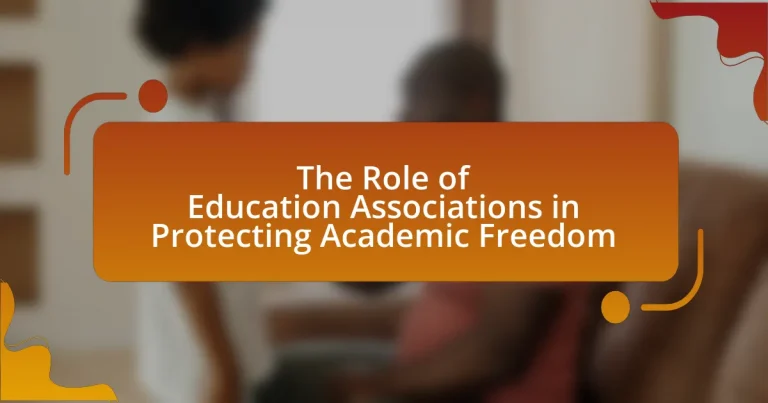Education associations play a vital role in safeguarding academic freedom by advocating for the rights of educators and promoting policies that support intellectual independence. These organizations, such as the American Association of University Professors (AAUP), define academic freedom as the right to engage in inquiry and express ideas without fear of censorship. The article explores the key principles of academic freedom upheld by these associations, the challenges they face, and the strategies they employ to protect educators’ rights. It also examines the impact of academic freedom on teaching, research, and societal progress, highlighting the importance of these associations in fostering an environment conducive to critical thinking and innovation.

What is the Role of Education Associations in Protecting Academic Freedom?
Education associations play a crucial role in protecting academic freedom by advocating for the rights of educators and promoting policies that support intellectual independence. These associations provide a collective voice for educators, enabling them to resist censorship and defend their ability to teach and research without external interference. For instance, organizations like the American Association of University Professors (AAUP) have established principles and guidelines that emphasize the importance of academic freedom, which are widely recognized in higher education. Additionally, education associations often engage in legal advocacy, offering support in cases where academic freedom is threatened, thereby reinforcing the legal protections for educators.
How do education associations define academic freedom?
Education associations define academic freedom as the right of educators and students to engage in intellectual inquiry and express ideas without fear of censorship or retaliation. This definition emphasizes the importance of autonomy in teaching, research, and discourse, allowing individuals to explore controversial or unpopular topics. For instance, the American Association of University Professors (AAUP) articulates that academic freedom is essential for the advancement of knowledge and the pursuit of truth, which is foundational to higher education. This perspective is supported by historical contexts, such as the AAUP’s 1940 Statement of Principles on Academic Freedom and Tenure, which has been widely adopted and serves as a benchmark for academic freedom policies across institutions.
What are the key principles of academic freedom upheld by education associations?
The key principles of academic freedom upheld by education associations include the freedom to teach, learn, and conduct research without interference or censorship. Education associations advocate for the protection of educators’ rights to explore controversial subjects and express diverse viewpoints, fostering an environment conducive to intellectual inquiry. These principles are grounded in the belief that academic freedom is essential for the advancement of knowledge and the promotion of democratic values. For instance, the American Association of University Professors (AAUP) emphasizes that academic freedom is vital for the pursuit of truth and the development of critical thinking skills among students.
How do these principles vary across different educational contexts?
Principles of academic freedom vary significantly across different educational contexts, influenced by factors such as institutional governance, cultural norms, and legal frameworks. For instance, in research-intensive universities, academic freedom is often robustly protected by institutional policies and supported by faculty associations, allowing for open inquiry and expression. Conversely, in some vocational or technical institutions, academic freedom may be more limited, focusing on practical skills and industry standards rather than critical discourse. Additionally, in countries with restrictive political environments, academic freedom can be severely curtailed, impacting educators’ ability to teach controversial subjects or express dissenting views. These variations highlight the importance of context in shaping the application and protection of academic freedom within educational settings.
Why is academic freedom important in education?
Academic freedom is important in education because it allows educators and students to explore, discuss, and challenge ideas without fear of censorship or retaliation. This freedom fosters an environment conducive to critical thinking and innovation, essential for academic growth and societal progress. Research indicates that institutions that uphold academic freedom tend to produce higher levels of student engagement and creativity, as evidenced by a study published in the Journal of Higher Education, which found that academic freedom correlates with improved educational outcomes and institutional reputation.
What impact does academic freedom have on teaching and research?
Academic freedom significantly enhances both teaching and research by allowing educators and researchers to explore, discuss, and disseminate ideas without fear of censorship or retribution. This freedom fosters an environment where innovative teaching methods can be employed, encouraging critical thinking and diverse perspectives among students. Furthermore, in research, academic freedom enables scholars to pursue inquiries that may challenge prevailing norms or address controversial topics, ultimately contributing to the advancement of knowledge. Studies, such as those conducted by the American Association of University Professors, demonstrate that institutions with strong protections for academic freedom report higher levels of faculty satisfaction and student engagement, underscoring its vital role in the educational landscape.
How does academic freedom contribute to societal progress?
Academic freedom contributes to societal progress by fostering an environment where ideas can be freely exchanged and critically examined. This freedom allows scholars to pursue research and teaching without fear of censorship or retribution, leading to innovative solutions to societal challenges. For instance, the development of vaccines and medical advancements often stems from research conducted in an atmosphere of academic freedom, as seen during the COVID-19 pandemic when scientists were able to collaborate and share findings openly. Furthermore, academic freedom encourages diverse perspectives, which can challenge prevailing norms and stimulate social change, as evidenced by movements for civil rights and social justice that have been supported by academic inquiry and discourse.
What challenges do education associations face in protecting academic freedom?
Education associations face significant challenges in protecting academic freedom, primarily due to political pressures, funding constraints, and institutional policies. Political pressures often manifest as legislative actions that seek to limit curriculum content or impose ideological conformity, undermining the autonomy of educators. Funding constraints can lead to a reliance on external sources that may impose conditions on academic programs, thereby compromising the independence of academic inquiry. Additionally, institutional policies may prioritize administrative interests over academic freedom, creating an environment where faculty members feel constrained in their teaching and research activities. These challenges collectively hinder the ability of education associations to advocate effectively for the protection of academic freedom.
What external pressures threaten academic freedom?
External pressures that threaten academic freedom include government censorship, corporate influence, and societal backlash against controversial ideas. Government censorship can manifest through laws that restrict academic inquiry or funding cuts to institutions that promote dissenting viewpoints. Corporate influence often leads to the prioritization of profit over scholarly integrity, resulting in research that aligns with business interests rather than academic rigor. Societal backlash, particularly in response to politically sensitive topics, can create an environment where scholars feel compelled to self-censor to avoid public or institutional repercussions. These pressures collectively undermine the independence necessary for robust academic discourse and inquiry.
How do internal conflicts within educational institutions affect academic freedom?
Internal conflicts within educational institutions significantly undermine academic freedom by creating an environment of fear and self-censorship among faculty and students. When disagreements arise over governance, ideology, or policy, they can lead to pressures that restrict open discourse and the exploration of diverse viewpoints. For instance, a study by the American Association of University Professors (AAUP) highlights that faculty members often feel compelled to avoid controversial topics in their research and teaching due to potential backlash from administration or peers, thereby stifling intellectual inquiry. This dynamic not only limits the scope of academic exploration but also diminishes the overall quality of education, as critical thinking and debate are essential components of a robust academic environment.

How do Education Associations Advocate for Academic Freedom?
Education associations advocate for academic freedom by promoting policies that protect educators’ rights to teach and research without censorship or external interference. These associations engage in lobbying efforts to influence legislation that supports academic independence, such as opposing restrictive laws and regulations that limit curriculum choices. For instance, the American Association of University Professors (AAUP) has historically defended academic freedom through legal challenges and public statements that emphasize the importance of free inquiry in higher education. Additionally, education associations provide resources and support for educators facing challenges to their academic freedom, thereby reinforcing the principle that academic inquiry should remain free from political or ideological constraints.
What strategies do education associations employ to promote academic freedom?
Education associations employ several strategies to promote academic freedom, including advocacy, policy development, and professional development programs. These associations actively lobby for legislation that protects the rights of educators and researchers, ensuring that academic inquiry remains free from external pressures. For instance, organizations like the American Association of University Professors (AAUP) have established guidelines and principles that outline the importance of academic freedom, providing a framework for institutions to follow. Additionally, education associations offer resources and training to help educators navigate challenges related to academic freedom, thereby reinforcing their commitment to uphold these essential principles in educational settings.
How do education associations engage with policymakers to influence legislation?
Education associations engage with policymakers to influence legislation primarily through advocacy efforts, including lobbying, providing research and data, and mobilizing their members. These associations often employ lobbyists to directly communicate with legislators, presenting evidence-based arguments that support their positions on educational policies. For instance, the National Education Association (NEA) regularly conducts surveys and research to highlight the impact of proposed legislation on teachers and students, thereby equipping policymakers with relevant information. Additionally, education associations organize grassroots campaigns, encouraging members to contact their representatives, which amplifies their influence by demonstrating widespread support for specific educational initiatives. This multifaceted approach ensures that the voices of educators are heard in the legislative process, ultimately shaping policies that protect academic freedom and enhance educational quality.
What role do public awareness campaigns play in advocacy efforts?
Public awareness campaigns are crucial in advocacy efforts as they educate the public, mobilize support, and influence policy change. These campaigns raise awareness about specific issues, such as academic freedom, by disseminating information through various channels, including social media, public events, and traditional media. For instance, a study by the Pew Research Center found that 64% of Americans believe that public awareness campaigns can significantly impact social issues, demonstrating their effectiveness in shaping public opinion and driving advocacy initiatives. By fostering a well-informed public, these campaigns empower individuals to engage in advocacy, ultimately leading to more robust support for causes like protecting academic freedom.
How do education associations support educators in exercising academic freedom?
Education associations support educators in exercising academic freedom by advocating for policies that protect their rights to teach and research without censorship. These associations provide legal assistance, resources, and professional development opportunities that empower educators to explore diverse perspectives and controversial topics in their classrooms. For instance, the American Association of University Professors (AAUP) has established principles that emphasize the importance of academic freedom, which serves as a framework for educators to defend their rights against institutional pressures. Additionally, education associations often engage in lobbying efforts to influence legislation that safeguards academic freedom, ensuring that educators can fulfill their roles without fear of reprisal.
What resources and training do education associations provide to educators?
Education associations provide a variety of resources and training to educators, including professional development workshops, online courses, and access to teaching materials. These associations often offer specialized training programs that focus on current educational practices, curriculum development, and classroom management techniques. For instance, the National Education Association (NEA) provides resources such as webinars and conferences that help educators stay updated on educational policies and teaching strategies. Additionally, many associations publish research and guidelines that support educators in implementing best practices in their classrooms, thereby enhancing their professional skills and knowledge.
How do education associations assist educators facing challenges to their academic freedom?
Education associations assist educators facing challenges to their academic freedom by providing legal support, advocacy, and resources for professional development. These associations often have legal teams that offer guidance and representation in cases where academic freedom is threatened, such as in instances of censorship or disciplinary actions. For example, the American Association of University Professors (AAUP) has a long history of defending faculty members’ rights, having intervened in numerous cases where academic freedom was at risk. Additionally, education associations engage in lobbying efforts to influence policy and legislation that protects academic freedom, ensuring that educators can teach and research without undue interference.
What are the Outcomes of Education Associations’ Efforts in Protecting Academic Freedom?
Education associations have successfully influenced the protection of academic freedom through advocacy, policy development, and legal support. These organizations have mobilized to challenge legislative and institutional threats to academic independence, resulting in the establishment of clearer guidelines and protections for educators and researchers. For instance, the American Association of University Professors (AAUP) has played a pivotal role in formulating standards that safeguard academic freedom, which has been recognized in various court rulings affirming the rights of faculty members to engage in research and teaching without undue interference. Additionally, education associations have facilitated awareness campaigns that highlight the importance of academic freedom, leading to increased public support and institutional commitments to uphold these principles.
What successes have education associations achieved in safeguarding academic freedom?
Education associations have successfully advocated for policies that protect academic freedom, resulting in significant legal and institutional reforms. For instance, the American Association of University Professors (AAUP) has played a crucial role in establishing principles of academic freedom that are now widely adopted in university governance, influencing policies across numerous institutions. Additionally, education associations have mobilized to defend faculty members facing censorship or retaliation, exemplified by their involvement in high-profile cases that have led to reinstatements and public support for academic rights. These efforts have contributed to a more robust framework for safeguarding academic inquiry and expression, as evidenced by the increased number of universities adopting formal statements on academic freedom in their policies.
How have specific cases demonstrated the effectiveness of education associations?
Education associations have demonstrated their effectiveness through specific cases such as the American Association of University Professors (AAUP) intervening in the case of a professor at the University of Illinois, who faced termination for expressing controversial views. The AAUP’s involvement led to a public outcry and ultimately the professor’s reinstatement, highlighting the association’s role in defending academic freedom. Additionally, the National Education Association (NEA) successfully advocated for the protection of teachers’ rights in various states, resulting in legislative changes that safeguard educators from unjust dismissal. These instances illustrate how education associations actively protect academic freedom and influence policy to benefit educators.
What metrics can be used to measure the impact of these efforts?
Metrics that can be used to measure the impact of education associations in protecting academic freedom include the number of policy changes influenced, the frequency of advocacy initiatives undertaken, and the level of member engagement in these efforts. For instance, tracking the number of legislative bills supported or opposed by education associations can provide concrete evidence of their influence on academic freedom policies. Additionally, surveys measuring faculty perceptions of academic freedom before and after advocacy campaigns can quantify changes in sentiment, demonstrating the effectiveness of these associations’ efforts.
What future challenges and opportunities lie ahead for education associations?
Education associations face significant challenges and opportunities in the evolving landscape of academic freedom. One major challenge is the increasing pressure from political and social movements that seek to influence educational content and restrict academic discourse. For instance, legislation in various states has aimed to limit discussions on race and gender in educational settings, which can undermine the principles of academic freedom that education associations strive to uphold.
Conversely, these associations have the opportunity to advocate for policies that protect academic freedom and promote inclusive educational practices. By leveraging their collective voice, education associations can influence legislation and public opinion, fostering environments where diverse perspectives are valued. The rise of digital platforms also presents an opportunity for education associations to expand their reach and engage with a broader audience, facilitating discussions on academic freedom and best practices in education.
In summary, while education associations must navigate challenges posed by external pressures on academic freedom, they also have the opportunity to champion policies and practices that reinforce their foundational principles.
How might changes in technology affect academic freedom?
Changes in technology can significantly impact academic freedom by altering how information is disseminated and accessed. For instance, the rise of digital platforms has enabled broader access to scholarly work, fostering collaboration and innovation. However, it also raises concerns about surveillance, censorship, and the control of academic discourse by private entities. A study by the American Association of University Professors highlights that increased reliance on technology can lead to self-censorship among academics due to fear of repercussions from online scrutiny or institutional policies. Thus, while technology can enhance academic freedom by democratizing knowledge, it simultaneously poses risks that may constrain it.
What emerging trends should education associations be aware of in their advocacy?
Education associations should be aware of the increasing emphasis on digital equity in their advocacy efforts. As technology becomes integral to education, disparities in access to digital resources can hinder academic freedom and equity. According to a report by the Pew Research Center, 15% of U.S. households with school-age children lacked high-speed internet access during the pandemic, highlighting the urgent need for advocacy focused on bridging this digital divide. Additionally, education associations must address the growing concerns around curriculum transparency and the influence of political agendas on educational content, as evidenced by recent legislative actions in various states aimed at regulating what can be taught in classrooms. These trends underscore the necessity for education associations to advocate for policies that promote equitable access to technology and protect the integrity of academic curricula.
What best practices can education associations adopt to enhance their role in protecting academic freedom?
Education associations can enhance their role in protecting academic freedom by implementing policies that promote transparency, advocacy, and support for educators facing challenges. Establishing clear guidelines for academic freedom that outline the rights of educators and students fosters an environment where open discourse is encouraged. Advocacy efforts should focus on lobbying for legislation that safeguards academic freedom, as seen in the American Association of University Professors’ initiatives, which have historically influenced policy changes. Additionally, providing resources and legal support for educators who encounter censorship or retaliation reinforces the commitment to academic freedom. These practices collectively strengthen the association’s role in defending the principles of academic inquiry and expression.
How can collaboration with other organizations strengthen advocacy efforts?
Collaboration with other organizations can significantly strengthen advocacy efforts by pooling resources, expertise, and networks to amplify the message and reach a broader audience. When education associations partner with other entities, such as non-profits, community groups, or governmental organizations, they can leverage diverse perspectives and strategies, enhancing the effectiveness of their campaigns. For instance, a study by the National Education Association found that coalitions formed between various educational stakeholders led to a 30% increase in policy influence compared to isolated efforts. This collaborative approach not only increases visibility but also fosters a united front, making it more challenging for opposing forces to dismiss or undermine the advocacy initiatives.
What innovative approaches can be implemented to engage a broader audience?
Innovative approaches to engage a broader audience include leveraging digital platforms for interactive content and community-building initiatives. Education associations can utilize social media campaigns, webinars, and online forums to foster dialogue and share diverse perspectives on academic freedom. For instance, a study by the Pew Research Center found that 72% of adults use social media to connect with others, indicating its effectiveness in reaching wider demographics. Additionally, incorporating gamification elements in educational resources can enhance engagement, as research from the University of Colorado shows that gamified learning increases participation rates by up to 50%. These strategies not only broaden reach but also create inclusive environments for discussion and collaboration.


